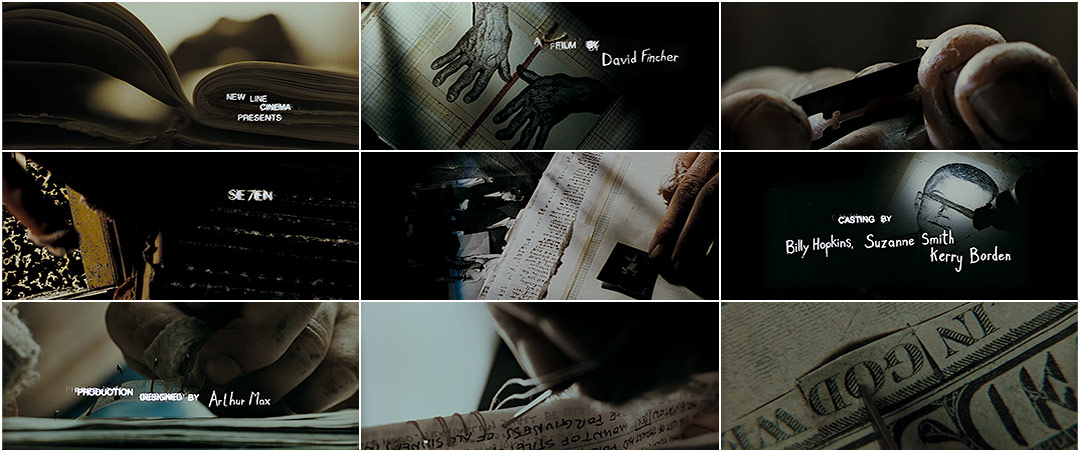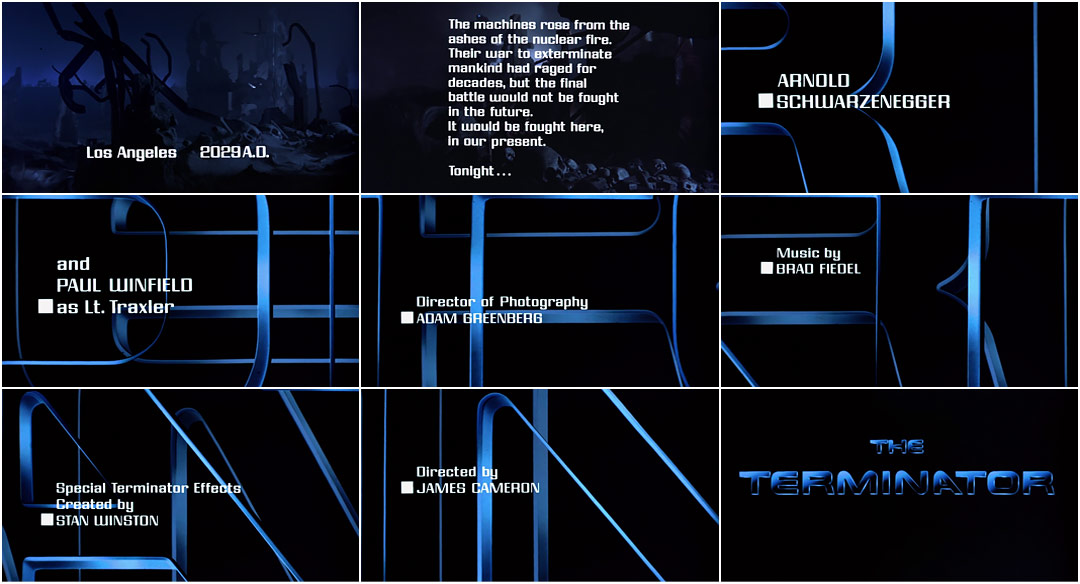

Example of typography used for title and shot by shot portrayal of opening sequence to the film 'Se7en'
In contemporary times when films were first being developed, the formulaic style was to have an over-black canvas where the titles portrayed at the beginning included many of the people involved. An example of this is the opening sequence to 'Blade Runner' (1982) where a subtle score accompanies some diegetic sounds and an over-black screen. The director, Ridley Scott (well known for his work in the thriller genre) cleverly did this to get the audience to engage with all their senses besides vision which made the interpretations very varied and left the audience with different emotions once they were finally shown something.
Whilst, more modern thriller films make use of of other aids to help get a point across. Evidently, big dramatic/triumphant scores are used to evoke emotions out of audiences, as well as conveying what type of film it is since certain sounding scores are associated with a genre - e.g. happy/upbeat tone resembles romantic/comedy films and fast paced dramatic scores usually represent action films. Moreover, visual effects take precedence as that is what modern directors feel this is what draws in and engages audiences - especially considering that there are categories at award ceremonies for 'Best Visual Effects'. For example, the film 'Prometheus' (2012) was mainly centred around the stunning visual effects of what the on set locations and CGI (Computer Generated Images) had to offer.
Below are some example of opening title sequences that I have analysed:


The opening sequence to 'Terminator' (1984) begins with a production title of the production companies involved 'Hemdale Presents A Pacific Western Production of A James Cameron Film' on an over-black canvas to show the studio responsible for distributing the film and the director who made it. Then it fades from black to an extreme long shot of Los Angeles in 2029 A.D. denoted by the tableau. The diegetic ambient sound of the wind acted as a sound bridge to show that this location resembles characteristics of a desert. The tone given is that this is set in a dystopian world due to the low key lighting and the destroyed debris of buildings. It is also emphasised that it is set in the future because the asynchronous sound of a spaceship is made synchronous when a spaceship comes flying in. The panning shot of the spaceship then cuts to a machine crushing skulls on the ground and cuts again to a close up of it firing lasers at somebody. This connotes that a war has occurred and many lives have been lost because of it and is supported further by the soldier costume worn by the actor denoted by the helmet and gun. Text then appears giving the audience some context as to why everything that has been shown is the way that it is and also gives a hint and what is going to happen in the rest of the film when it says 'but the final battle would not be fought in the future. It would be fought in our present. Tonight...' An over-black transition is accompanied by the iconic/signature score used in all the Terminator films and text moving horizontally in the background revealed at the end to be the futuristic like typography of the film title (shining ident). The production titles then start with firstly key actors (Arnold Schwarzenegger...), editor , director of photography, music composer, special effects, writers, producers and finally the director as last. Throughout the showing of the titles, the score builds up to let the audience know that the film is about to start again and that the interval time for them to be thinking about what is going to happen next is over.
'Argo' (2012) begins by showing the titles for the production companies 'GK Films' and 'Warner Bros.' who funded the film in association with others as well. The typography of the titles are visually retro looking which links in with the idea that this film is based on a historical event (especially the first Warner Bros. logo shown which is an homage to what it used to look like in the 70s). This is emphasised further with a slow subtle score connoting the seriousness of the subject and the voiceover narration explaining historical context. As well as this, at the end of the sequence, text depicts that the film is 'based on a true story' and the tableau 'U.S. Embassy, Iran -November 4, 1979' brings us towards the film's present setting. It has been used to act as a prologue that gives background information on the events leading up to when the film starts at the present. Throughout the sequence, an animated storyboard is being visualised through various panning shots as a narrative structure device which links in with what the film is about - the making of a fake film. Transitional effects are used and portrayed by a shot of the storyboard turning into a reenactment by actors. The realism of the footage is denoted by the black and white colour as well as the kinetic camerawork.
The sequence to 'Jack Reacher' (2012) opens with a close up of a hand pulling a lever showing that the person is working and it is later denoted in a zoom in shot that he is in a workshop. Throughout the sequence, titles fade in and out through transitioning showing production titles such as key actors, producers, music composer, director of photography... As well as this, the non-diegetic score builds up slowly through the sequence until the moment the sniper aims his rifle which is the point that the audience has been ultimately led up to and was in suspense the whole time. A long edit for the rest of this scene is used to build tension and anticipation in the audience until the plot climax when he takes the shot through his scope denoted by the point of view shot.The silence afterwards reflects the sniper's attitude as a cold blooded killer and the realistic preparation that a sniper goes through when planning a kill. Cross cutting is also used to show some sort of relationship between the two of them because they end up being protagonist and antagonist. An establishing shot shows that they are in a city and a slow crane shot upwards later implies that he is driving up a spiral road in a car parking lot where he sets up and was ultimately headed to. Overhead shots are portrayed very often which gives the audience the feeling that they are omniscient and can see all that is happening. This is done on purpose so that later on in the film when the protagonist is trying to solve the shooting, the audience are given the information beforehand giving an atmosphere of dramatic irony.


No comments:
Post a Comment